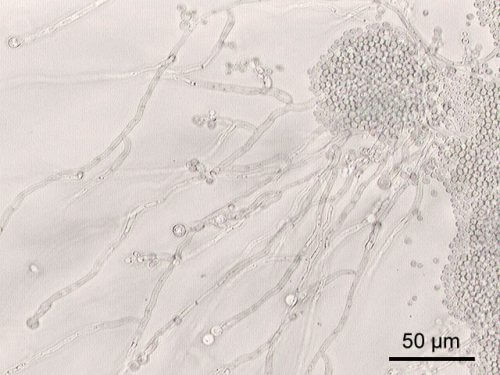Fungal infections are common among various animals including humans. One of the main sources of these infections is Candida, a yeast that is regularly present in our bodies. This fungus takes advantage of disruptions in the functioning of the organism to spread and damage it, and most people will experience a fungal infection at least once in their lives somewhere in their body - on the skin, the digestive system or the intimate organs

Researchers from the Faculty of Biotechnology and Food Engineering at the Technion cured fungal infections using a bacterium that resides in the soil. The study published in the journal Advanced Functional Material Conducted under the guidance of Associate Professor Beaz Mizrahi and led by student Maayan Lofton and Dr. Ayelet Orbach.
Fungal infections are common among various animals including humans. One of the main sources of these infections is Candida, a yeast that is regularly present in our bodies. This fungus takes advantage of disruptions in the functioning of the organism to spread and damage it, and most people will experience a fungal infection at least once in their life somewhere in their body - on the skin, the digestive system or the intimate organs.
The frequency of fungal infections is constantly increasing due to the aging of the population and possibly also due to global warming. Other reasons for the increase in incidence are the use of drugs that suppress the immune system and the increasing use of antibiotic drugs, which support Candida indirectly - through damage to the balance of bacteria in the body. The drugs that are currently administered by ingestion against fungal infections are characterized by low effectiveness, a variety of side effects such as headaches and rashes, and in some cases also life-threatening liver and kidney toxicity. Furthermore, in recent years, Candida strains resistant to existing drugs have also been discovered.
The Technion researchers examined the possibility of treating candida using the bacterium Bacillus subtilis, which naturally secretes substances that inhibit the growth of candida. This mechanism developed in the bacterium as part of its fight against Candida on the soil, habitat and plant roots.
According to Mishna Mizrahi, "Our first challenge was to develop a transport system that would allow the bacteria to be applied to the contaminated lesion without harming their ability to multiply and secrete the medical substances at the target site." The researchers developed a unique gel that is in a liquid state in the refrigerator and at room temperature (so that it is convenient to apply) but hardens within seconds after applying it to the skin. In addition to the polymeric substances responsible for hardening, the gel also contains nutrients that ensure that the bacteria will continue to live on the skin and thus be able to "treat" the infection.
The researchers applied the innovative formula to skin tissue after marking it with a fluorescent substance, and showed that the formula penetrates deep into the skin but not into the underlying blood vessels. Later, the effectiveness of the formula was tested on mice suffering from a fungal infection. In the control groups, the one that received an ointment without bacteria and the one that was not treated at all, the infection continued to develop. In the group treated with the bacterial gel developed at the Technion, on the other hand, the skin healed quickly. Furthermore, testing the new treatment compared to treatment with the common ketoconazole ointment demonstrated not only the superiority of the technion gel but also the fact that it is free of any side effects.
The researchers point out that beyond the development of the specific gel, a new model for drug treatment is being developed here: a tiny factory, which, after being inserted into the desired target in the body, the bacteria inside begin to produce the active substance. This is in contrast to the usual pharmaceutical model, where the medicine moves inside the body and parts of it may break down along the way. The researchers hope that in the future it will be possible to use the innovative model to treat a variety of diseases, including psoriasis, acne, various infections and even cancer.
For the full article in Advanced Functional Material click here
for a video presenting the study. Credit: The Laboratory for Biomaterials - Prof. Mishna Beaz Mizrahi
More of the topic in Hayadan:
